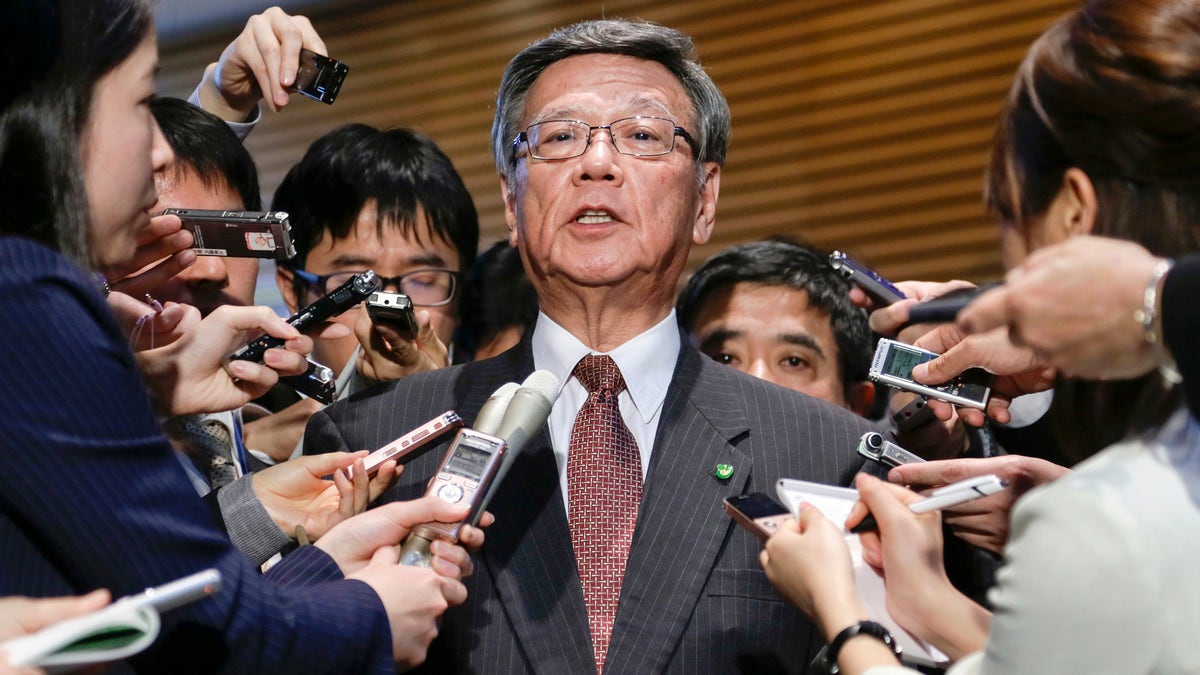
FILE - In this March 4, 2016 file photo, Okinawa Gov. Takeshi Onaga is surrounded by reporters after a meeting with Japanese Prime Minister Shinzo Abe at the latter's official residence in Tokyo. Japan and the U.S. have marked a partial return of the land used by American troops to Okinawa in a ceremony on the southern island Thursday, Dec. 22, 2016, , but there was no sign the move was helping to lessen protests against the heavy U.S. military presence. Demanding an unconditional land return, Okinawa Gov. Onaga skipped Thursdays ceremony and joined a protest. (Kimimasa Mayama/Pool Photo via AP, File)
TOKYO – Japan and the U.S. marked a partial return of the land used by American troops to Okinawa in a ceremony Thursday on the southern island, but there was no sign the move was helping to lessen protests against the island's heavy U.S. military presence.
Nearly 10,000 acres, about half the plot of land, was returned to Okinawa in exchange for helipads for Osprey tilt-rotor aircraft being built nearby. Residents say the deal only transfers the burden.
U.S. Ambassador Caroline Kennedy called the reversion "a milestone" in the U.S.-Japan alliance in her speech at the ceremony in Nago. "This return will reduce our footprint by about 20 percent (of base facilities on Okinawa) and allow this pristine natural environment to be enjoyed by future generations of residents and visitors to Okinawa." The land is a rich forest with rare birds and other fauna and flora and had been used as jungle training by U.S. troops.
Demanding an unconditional land return and opposing Osprey deployment on the island, Okinawa Gov. Takeshi Onaga boycotted the ceremony and joined a protest against the U.S. military presence on the island, his choice highlighting differences between the central government and Okinawa.
At a rally held near the ceremony venue, Onaga told thousands of cheering people that the land return in exchange for a new U.S. military facility is deceptive and is not reducing Okinawa's burden.
"The land return ceremony one-sidedly held by the central government is nothing but a proof they have no intention whatsoever to be considerate of our suffering," Onaga said. He renewed his demand that Ospreys be removed from Okinawa and that any U.S. military base planned for a closure simply be returned and not relocated.
An Osprey crash-landing off Okinawa last week has added to safety concerns and anti-U.S. base sentiment. It landed in shallow waters off the eastern coast after its propeller was damaged during training for midair fueling. All five crewmembers ejected and survived.
The return of the northern land area was agreed on in 1996 but delayed due to protests over building helipads. A new site was chosen and the central government resumed construction of the helipads this year. The helicopter landing sites in tiny Takae village are now operational.
Protests and a legal battle between the central and Okinawan governments have also stalled the planned relocation of Air Station Futenma for two decades.
More than half of 50,000 U.S. troops in Japan are stationed on Okinawa under the bilateral security pact. Many people on the island have long complained about noise, pollution and crime linked to U.S. military base.
